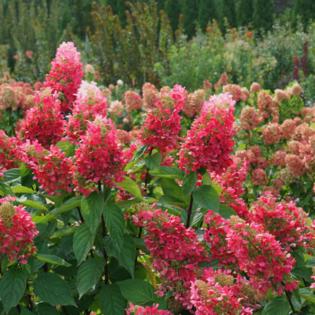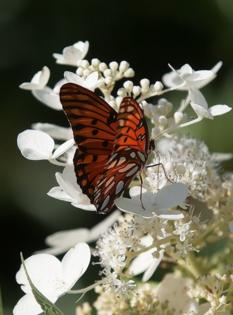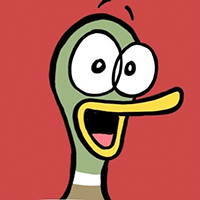On Gardening: Pinky Winky goes Prime perfect for landscape and pollinator habitat
Published in Gardening News
Pinky Winky has gone Prime! One of my all-time favorite hydrangea paniculata varieties, Pinky Winky is now being offered as Prime. This means you can now choose Pinky Winky or Pinky Winky Prime hydrangea for your landscape or pollinator habitat, as I will explain.
Your first question is what the difference is, and that would be size. It is larger, reaching 6 to 9 feet tall and as wide. And as Proven Winners states, the blooms are massive.
When August rolls around and butterfly season is peaking, Pinky Winky and Pinky Winky Prime stand ready to supply the nectar. After watching panicle hydrangeas for years, I can tell you that while they are all beautiful, they are not all the same when it comes to bees and butterflies. Pinky Winky and now Pinky Winky Prime are at the top.
Many will find this odd so let me explain. First, know that I am not talking about larval host plants. I’m not talking milkweeds, passion flowers, dill, tulip trees or pipevines. I am talking about nectar plants. You are probably thinking you’ve been growing hydrangeas for years and never seen a pollinator. I will be quick to say that’s OK, we need shrubs with beautiful flowers in the landscape.
Pinky Winky and the new Pinky Winky Prime are good examples. A close examination will show they have large sterile flowers that give us the proverbial show and go in the landscape, the "wow factor" so to speak. Among those sterile flowers are tiny fertile flowers. Now a lot of literature will call the sterile ones flowers and the perfect flowers florets. I like that.
But some in the industry want to call this lacecap, a term we have given more so to hydrangea macrophylla and hydrangea serrata varieties. I don’t like that. The flower structure doesn’t look like a cap. I’m simply a horticulturist with an opinion.
So back to Pinky Winky and Pinky Winky Prime. I have already referred to the large sterile flowers as the wow factor in the landscape. A giant Eastern Tiger Swallowtail on these tiny fertile flowers is certainly a wow factor of a different sort.
I’ve mentioned Eastern Tiger Swallowtails, but I have photos of Palamedes Swallowtails, Gulf Fritillaries, Red-banded Hairstreaks, Honeybees, large Tachnid Flies that look like bees and other flying creatures like the black-winged Dahana moth. In other words, a large Pinky Winky hydrangea can be a pollinator smorgasbord come July and August in the South. Of course these are recommended for zones 3a to 8b so a large area of the country can enjoy them.
These hydrangeas open the door for creative plant partnerships in the habitat garden. Pollinator magnets like Meteor Shower verbena, Truffula Pink gomphrena and Luscious lantanas all make great companions with the new Pinky Winky Prime. By all means, don’t forget Proven Winners great buddleias. Consider also songbird loving plant partners like Pearl Glam beautyberry to add to your habitat.
I have Limelight Prime, Little Lime Punch and Puffer Fish for show and go, but the camera always comes out for the visitors to my varieties with both sterile and fertile florets, like Pinky Winky and the new Pinky Winky Prime. If you live in a region of the country where panicle hydrangeas color up, then you will absolutely love Pinky Winky Prime.
____
(Norman Winter, horticulturist, garden speaker and author of “Tough-as-Nails Flowers for the South” and “Captivating Combinations: Color and Style in the Garden.” Follow him on Facebook @NormanWinterTheGardenGuy.)
(NOTE TO EDITORS: Norman Winter receives complimentary plants to review from the companies he covers.)
©2024 Tribune Content Agency, LLC













Comments